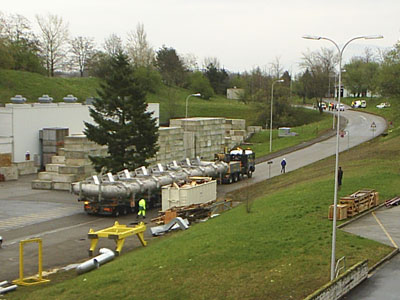Difference between revisions of "TestPage"
| Line 6: | Line 6: | ||
<math>a +b</math> | <math>a +b</math> | ||
| + | <p>It's interesting to study the Hep neutrinos because no one has seen them yet. One of SNO's competitors (Super-Kamiokande) has looked, but hasn't seen anything. SNO should be more sensitive for seeing Hep neutrinos since we can see neutrinos via a nuclear reaction called the "Charged Current" reaction; Super-Kamiokande can not see neutrinos via this reaction. SNO's heavy water makes this reaction possible. In the Charged Current reaction, the incoming solar neutrino collides with the neutron in a hydrogen nucleus in the heavy water. The reaction of the neutrino with the neutron produces a proton and an electron. We can't see the proton in SNO, but the electron that is created is moving close to the speed of light so produces a special type of light called Cerenkov light. SNO's 10,000 light detectors are specially designed to see the Cerenkov light.</p> | ||
| + | |||
| + | <p>With some luck, SNO might see some flashes of light that look like Hep neutrinos. This would be a very interesting discovery. Only time (plus some effort!) will tell whether we have seen any of the elusive Hep neutrinos in SNO.</p> | ||
| + | |||
| + | <p></p> | ||
Revision as of 20:19, 11 April 2005
dit is de testpage
and the nikhef homepage
It's interesting to study the Hep neutrinos because no one has seen them yet. One of SNO's competitors (Super-Kamiokande) has looked, but hasn't seen anything. SNO should be more sensitive for seeing Hep neutrinos since we can see neutrinos via a nuclear reaction called the "Charged Current" reaction; Super-Kamiokande can not see neutrinos via this reaction. SNO's heavy water makes this reaction possible. In the Charged Current reaction, the incoming solar neutrino collides with the neutron in a hydrogen nucleus in the heavy water. The reaction of the neutrino with the neutron produces a proton and an electron. We can't see the proton in SNO, but the electron that is created is moving close to the speed of light so produces a special type of light called Cerenkov light. SNO's 10,000 light detectors are specially designed to see the Cerenkov light.
With some luck, SNO might see some flashes of light that look like Hep neutrinos. This would be a very interesting discovery. Only time (plus some effort!) will tell whether we have seen any of the elusive Hep neutrinos in SNO.

